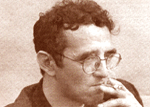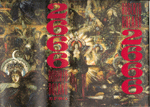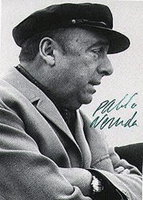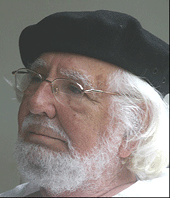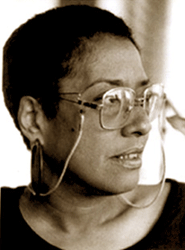Notes on 20th and 21st
Century Literature
(1910-present)
Prose
Fiction (Novel and Short Story)
1910-1949 Regionalism, Nationalism, Novel of the
Mexican Revolution
Starting around 1910, the basis of
Latin American regionalism is set up as a combination of various elements;
namely, the triumph of earlier aspects of social realism, the innovative
language and style of modernismo, and
the poetical revolutions that occurred after World War I. What is most notable
in the prose of this period is a stronger sense of Latin American identity.
Writers perceive objective reality without economic or political
abstractionism. Gone, however, is the 19th century emphasis on the
detailed depiction of local customs that were thought of as picturesque,
typical, quaint. In the place of costumbrismo,
we find an increased awareness of the uniqueness and power of Latin American
nature. For example, one of the major writers of this period, Ciro Alegría
(Perú, 1909-1967; El mundo es ancho y
ajeno / Broad and Alien is the World,
1941), called attention to the "acción monstruosa de la naturaleza salvaje
frente a los conatos civilizadores
Some prominent
Latin American writers of prose fiction in this period are:
José
Eustacio Rivera (Colombia, 1889-1928) published his masterpiece, La vorágine, in 1924. Rivera was very active and accomplished man:
he taught in public high school (Escuela Normal Superior); he was a lawyer with
a law degree from the National University in Colombia; he held several public
prosecutor positions; he traveled to Perú and México as a diplomat; he served
on an international commission concerning border disputes between Colombia and
Venezuela; he was an inspector for Colombian oil fields; he explored the
interior regions (los llanos) and the
Orinoco River; and he died in New York City. Rivera's humanistic prose
expression, which comes out of the modernista
tradition, displays a marked tendency toward melodrama and exoticism, in which
he blurs the dividing line between fantasy and reality. In La vorágine, we are presented with a portrait of man (humans)
overwhelmed by the weight of nature in terms that show humans defeated in their
ferocious and epic struggle against nature. The atmosphere is that of
collective madness because the human characters are in direct contact with
uncontrollable forces of destruction.
Rómulo
Gallegos (Venezuela,
1884-1960) began literary writing after 1910, and his novels were all written
after 1920. His masterpiece, Doña Bárbara
(1929), is perhaps the most emblematic of the early twentieth century writers
in
Ricardo
Güiraldes (Argentina, 1886-1927) was a well-to-do writer with a European
cultural background who turned his attention to regional Latin American
traditions and scenes. He sought to create an authentic Argentinian literary
style and identity (i.e., una
argentinidad). In this pursuit he depicted rural people from the
Benito
Lynch (Argentina, 1885-1951) wrote about Argentinian gauchos not in a
mythical vein but rather as flesh and blood, three dimensional people; indeed,
he tended to view them as criminals. One of Lynch's most prominent works is El inglés de los huesos (The Englishman
of the Bones; 1924). In this novel Lynch, who himself had been immersed in
rural Argentinian life, achieves a kind of photographic realism via aesthetic
balance and a rather faithful reproduction of the authentic dialect and style
of the gauchos themselves. Whereas Güiraldes seems to wax nostalgic about
gauchos, Lynch projects his own first-hand knowledge of them. In Lynch's art,
there is, however, no vanguardism or impressionism because he followed directly
in the tradition of Spanish regionalism.
Eduardo
Barrios (Chile, 1884-1963) worked in the humanities areas of the novel,
short store, and theater. He was born in
Miguel Ángel Asturias
Rosales (Guatemala, 1899-1974). He
studied anthropology, history, and indigenous cultures in
Agustín Yánez (México, 1904 - 1980). In
addition to being a governor of the Mexican state of Jalisco and a college
professor, he was a major mid-century novelist. A product of the Latin American
middle-class intelligentsia, his philosophical outlook was consonant with the
enlightened European views following both World Wars. In other words, in his
works he adopted a new metaphysical style that he applied to a world that had
lost a sense of its organizational place in history. In the Mexican cultural
milieu he paints elegant narrative portraits of the conflict between Western
civilization and what has traditionally been seen as Latin American
"primitivism". This conflict plays out is terms of individual
consciousnesses. Yáñez' major novel is Al
filo
There
are, of course, many important Latin American writers during this period of the
first half of the twentieth century. Two more that should be mentioned in order
to complete this brief survey of the entire continent are Jorge Icaza (Ecuador, 1906-1978) and Ciro Alegría (Perú, 1909-1967 ). These two authors narrate
characters and societies from the Andean regions. Icaza's most notable novel is
Huasipungo (1934), which features
realistic language used to present social criticism from a Marxist
revolutionary ideological perspective. Like other works (prose narratives,
essays, theater), this novel sheds brutal light on the tragedy of Ecuatorian
indigenous peoples (Indians) by focusing on an native family that is forced to
accept its animal-like destiny. Characters include Indians stripped of their
land, cruel Occidental (i.e., Criollo, Spanish) exploiters. Icaza's goal is to
shock readers out of their apathy by means of literature that borders on
propaganda. Meanwhile, in Perú, Ciro Alegría was a member of the leftist
Peruvian political party APRA. He was exiled to
Mariano Azuela (México): see essay
about Azuela in: => Notes on the Humanities in the Mexican
Revolution.
José Rubén Romero (México): see essay
about Romero in: => Notes on the Humanities in the Mexican
Revolution.
Martín Luis Guzmán (México): : see
essay about Guzmán in: => Notes on the Humanities in the Mexican
Revolution.
Gregorio López y Fuentes (México): see
essay about López y Fuentes in: => Notes on the Humanities
in the Mexican Revolution.
1949-1999 Magical Realism (lo real maravilloso), the Latin American Boom, and Beyond
Alejo Carpentier (Cuba, 1904-1980). He was a major
Latin American and, of course, Cuban, musicologist, journalist, pianist,
ambassador, and writer, and most notably and lastingly, novelist. Although
Carpentier was born in La Habana of French and Russian parents at the beginning
of the twentieth century, his humanistic influence becomes truly significant at
mid-century. In 1921 he studied music and architecture, but he did not finish
those studies; the following year he published his first essays. From 1924 to
1928 he was the editor of the Cuban magazine Carteles. In 1927, as the founder of a minority anti-government
political party, he was jailed for his political activities against the
dictator Machado (=> Cuba).
For the following eleven years he lived in exile in
The
1949 introduction to El reino de este
mundo (The Kingdom of this World), a novel about the Haitian revolution,
the desire for freedom and justice, history, and imagination, is titled
"Problemática de la actual novela latinoamericana" (Questions about
the current Latin American novel), Carpentier discusses the challenges to
producing a novel in developing regions of the world such as Asia and Latin
America. In the essay he says this:
"In
a period characterized by a great interest in the Afro-Cuban folklore that was
"recently discovered" by my generation's intellectuals, I wrote a
novel—¡Ecue-Yamba-O!—whose characters
were blacks from the rural class of that period. I ought to point out that I
was raised in the Cuban countryside in contact with Black peasants and the
children of Black peasants. Later, I became very interested in the practices of
santería and ñañiguismo [secret Afro-Cuban religious beliefs], and I attended a
lot of their rituals and ceremonies. By means of such "documentary
research" I wrote a novel that was published in
Later
in this essay he says, in creating their works, Latin American humanists must
take into consideration a broad spectrum of what he calls contexts: racial,
ethnic, economic, political, culinary, musical, ideological, historical,
cultural, and stylistic. Furthermore, these humanists must account for lo ctónico (atemporal or inter-temporal
universality; chronological dislocations; see: => HUM 2461 Terms List), lo autóctono (what is autochthonous,
uniquely authentic in
"Light,
certain peculiarities of light, modify perspectives, values of distance,
placement of planes, in terms of the angle of observation taken by the Latin
American novelist. Light in Havana is not the same as Mexico's (there's an
enormous difference between both of them: in Mexico the light brings far
distances closer, but in Havana it makes what is nearer seem evanescent); nor
is light then same in Rio de Janeiro or Santiago de Chile, or even in
Port-au-Prince, where the presence of mountains that block the wind and the
clouds changes the values of illumination. To speak about the haze in
Now
we take a look at his essay on lo real
maravilloso published in Tientos y
diferencias. You can see this essay in either of these two formats:
HTM
format: => "About the Latin American real maravilloso".
PDF
format: => "About the Latin American real maravilloso".
Jorge Luis Borges (1899-1986;
Juan Rulfo (1917-1986; México) was born in
Jalisco, México as Juan Nepomuceno Carlos Pérez Rulfo Vizcaíno, but he is
universally known simply as Juan Rulfo. Until he was ten years old he lived in
a small pueblo with his grandfather, after which he lived in an orphanage. In
1934, he planned to attend the Universidad de Guadalajara, the great university
in the capital of
Gabriel García
Márquez (1927 -
2014; Colombia): for an introductory chronology of his life and works, see: => García Márquez
Mario Vargas Llosa (b. 1936; Perú) is one of the
original prose fiction writers and essayists of the famed “Generación del
Boom,” which began roughly in 1962 and spread throughout Latin America and
which became perhaps the most internationally renowned literary movement of all
time. Among his most famous novels are: La ciudad y los perros (1962); La
casa verde (1965); Conversación en la
Catedral (1970); Pantaleón y las
visitadoras (1973); La guerra del fin
del mundo (1985); El paraíso en la
otra esquina (2003); Travesuras de la
niña mala (2006). In
1990, he ran for the presidency of Perú, but he lost to the winner, the
presidential dictator, Alberto Fujimori. Among his many national and
international awards is the Nobel Prize for Literature in 2010 and the (USA)
Library of Congress’s Living Legend award. In 2015 he published a book-length
book titled Notes on the Death of Culture, and in 2016 he published the novel
Cinco esquinas. His Brazilian war novel La
guerra del fin del mundo (1985) is acclaimed by many as his masterpiece. It
is based in part on the magnum opus by the Brazilian writer Euclides da Cunha, Os Sertões (1902), which is about the brutal
civil war in the NE Brazilian backlands of Canudos. For an article on Vargas
Llosa’s appearance in Washington, D.C. on the occasion of his acceptance of the
Library of Congress award, see: => New York Times article “Love in the Time of
Spectacle” (< http://www.nytimes.com/2016/04/14/books/mario-vargas-llosa-on-love-spectacle-and-becoming-a-legend.html?ref=arts>).
Other
prominent Latin American writers of prose fiction in this period are:
José
Guimarães Rosa (1908-1967;
José Lezama Lima (1910-1976; Cuba)
María
Luis Bombal (1910-1980; Chile)
José
María Arguedas (1911-1969; Perú): Los
ríos profundos (1962)
Ernesto
Sábato (b. 1911; Argentina): El túnel
(1948)
Jorge Amado (1912-2001;
Julio Cortázar (1914-1984; Argentina)
Elena
Garro (1916-1998; México)
Clarece
Lispector (1920-1977; Brazil)
Marco
Denevi (1922-1998; Argentina)
José
Donoso (1924-1996; Chile)
Rosario
Castellanos (1925-1974; México): Trayectoria
del polvo (1948); Balún Canán
(1957); Oficio de tinieblas (1962)
Carmen
Naranjo (b. 1928; Costa Rica)
Carlos
Fuentes (b. 1928; México)
Guillermo
Cabrera Infante (b. 1929; Cuba)
Elena
Poniatowska (b. 1932; México)
Mario
Vargas Llosa (b. 1936; Perú): La ciudad y
los perros (1962); La casa verde
(1965); Conversación en la Catedral
(1970); Pantaleón y las visitadoras
(1973); La guerra del fin del mundo (1985);
El paraíso en la otra esquina (2003);
Travesuras de la niña mala (2006).
Luis
Rafael Sánchez (b. 1936; Puerto Rico): La
guaracha del Macho Camacho
Rudolfo
Anaya (b. 1937; Aztlán)
Hernán
Castellano-Girón 1937-2016; Chile): Calducho
o las serpientes de la calle Ahumada (1998)
Marie-Claire
Blais (b. 1939; Québec)
Antonio Skármeta (b. 1940; Chile): El
cartero de Neruda (1985)
2001-present Post-Magical Realism and Twenty-first Century Prose Narrative
Some prominent
Latin American writers of prose fiction in this period are:
Julia Álvarez (b. 1950;
Laura Restrepo (b. 1950; Colombia): Delirio (2004)
Pedro Ángel Palou (b. 1966; Mexico): Zapata (2006)
Jorge Volpi (b. 1968; Mexico):A
pesar del oscuro silencio (1992); En busca de Klingsor (1999); La paz de los sepulcros (2006)
Junot Díaz (b.1968; Dominican
American; New York): The Brief Wondrous
Life of Oscar Wao (2007)
Hernán Castellano-Girón (1937-2016; Chile): Kraal (short
stories, 1965); El bosque de vidrio (short
stories, 1969); Nosferatu (film,
1973-1986); El automóvil celestial (poetry, 1977); Teoría del cuerpo pobre (poetry, 1978); Los
crepúsculos de Anthony Wayne Drive (poetry, bilingual, 1983); Otro cielo (poetry, 1985); El ilegible: las nubes y los años (novella,
1988); Calducho o las serpientes de la
calle Ahumada (novel, 1998); Un Orfeo
del Pacífico (Rosamel del Valle anthology, 2000); El huevo de Dios y otras historias (short stories, 2002); Nosferatu, una escenito criolla (film
script, 2009); Las palabras disperas (essay,
2010); Llamaradas de nafta (novel,
2012); Espectros (semi-autobiographical
novel, 2007-2012); El invernadero (novel,
2013); Coral de invierno (poetry,
bilingual edition, 2015);
Hernán Castellano was born in
Coquimbo, Chile. He earned a doctorate at the University of Chile in Santiago
de Chile (in 1961 in Chile: título de
profesor) in chemistry and pharmacy. In 1967 he taught his specialization
(agronomical chemistry) at the University of Chile. At the time coup d’état by
Chile’s military under the command of Gen. Augusto Pinochet in September 1973
(dictator 1973-1990), Hernán Castellano-Girón was expelled from his position
and forced into exile. First he went to Italy, where he earned a graduate
degree (laurea) in Latin American
literature with a thesis (1981) on the Chilean writer Rosamel del Valle
(1901-1965). With a doctoral fellowship in hand, he went to Wayne State University
in Detroit where he earned a doctorate (1985). Next he got a full-time teaching
position at California Polytechnic State University (Cal Poly, San Luis
Obispo), which hiring lead to tenure and promotion as a professor of Spanish,
Italian, and Latin American literature and humanities. He worked closely with
the department chair, William Little, and the major Chicana poet, Gloria
Velásquez. He was named the
poet laureate of this city. In 2007 he retired and returned to Chile, where he
bought a house (2008) on Isla Negra, where Pablo Neruda had his famous seaside
home. In addition to being a poet, he was a writer of prose fiction (short
stories, micro-stories, and novels), an award-winning essayist, winning a
Chilean national prize for an essay on Neruda, film maker, and painter. His
film, Nosferatu, is a Dracula-like
story based on Bram Stoker’s original novel and featuring an insane priest. Dr.
Ana Balakian, professor of French and comparative literature at New York University,
in her 1978 book on surrealism, said that Hernán Castellano was “the last of
the surrealists.” His paintings, which have a world-wide circulation and which
have been used as the illustration on many Spanish-language book covers,
certainly support Balakian’s assessment. About himself Hernán Castellano said
that his nearly unrecognized presence in Latin American literature was “pretty
secret” (“un escritor casi secreto”)
which was due to his “greatest sin, that he was original:” “ser original, llevar adelante un discurso
que no calza con ninguna de las líneas aceptadas y aceptables sobre todo in
narrativa” [to be original, to undertake a discourse style that does not
accord with any of the acceptable or accepted patterns, above all in
narrative]. As an example of his art here is one of his self-portraits:

Leonardo Padura (b.
1955; Cuba): Pasado perfecto (1991;
trans. 2007: Havana Blue); Vientos de cuaresma (1994; trans. Havana Gold, 2008); Máscaras (1997; trans. Havana
Red, 2005); Paisaje de otoño 1998;
trans. Havana Black, 2006); La novela de mi vida (2002); Adiós, Hemingway (2006); El hombre que amaba los perros (2009); Herejes (2014).
Padura is one of the most
prominent and talented of Latin America’s novelists since the last decade of
the 20th century and into the 21st century. He is an essayist,
short story writer, literary critic, and novelist. He came to prominence with
the first for novels, published from 1991 to 1998; they are known collectively
as the Four Seasons. These are sophisticated literature written fully within
the classical conventions of detective novels; that is the roman noir. Their protagonist is a Havana tireless and cynical
police detective, Mario Conde, who investigates murders in Havana, murders that
touch on some of the most explosive issues in communist Cuba, crimes that
involve corruption in the government and in the police department. Since Padura
never mentions the Cuban leadership by name, and since he never explicitly
denounced the regime, he has been able to explore the gritty realities of Cuban
life under the Castro regime without suffering—except for a two-year period in
the 1970’s—the ostracism, imprisonment, or exile that hundreds of other Cuban
members of the intelligentsia have suffered since 1959. Padura continues to
live in the home in which he was born in the suburbs of Havana with his wife
and two dogs.
Roberto Bolaño (1953 – 2003;
Chile) is perhaps
the most dynamic Latin American writer at the turn of the 21st
century.
|
|
Throughout his life he lived
variously in Chile, Mexico, El Salvador, France, and Spain. He was born in
Santiago, Chile. A dyslexic young man who had trouble in school, his
family moved to Mexico City in 1968; he then dropped out of school taking jobs
as a reporter and moving in activist left-wing political movements, which, in
Mexico at the time were nearly revolutionary (see: Generation of ’68).
According to his own account—which several commentators have called into
question—he returned to Chile in 1973 during the time of Augusto Pinochet’s
military coup against the democratic government of president Salvador Allende
(1970-1973). Bolaño said that he was arrested and spent a week in jail, from
whence he was rescued by friends who were prison guards. He narrates this
semi-autobiographical episode in his short story “Dance Card.” During the 1970s
he became an avowed Trotskyite, founded a minor literary movement he called infrarrealismo (sub-realism), but in his
novel Los detectives salvajes (The Savage Detectives; 1998) he parodied
his own literary movement. For a time he worked with the left-wing guerrilleros
in the Farabundo Martí National Liberation Front in during the civil war in El
Salvador. Afterwards he returned to Mexico, where he was a misfit poet—what
some have called a “literary enfant
terrible.” It is possible, at least according to his own account, that he
was addicted to heroin. In 1977, he moved to Spain, settled in the Catalan
village of Blanes, married, and had a son, who was born in 1990. In Blanes, he
had various odd jobs in cafés, campgrounds, hotels, and garbage collection
agencies. After his son was born he switched from poetry to narrative fiction
because, as he explained, he could earn a living publishing fiction and he felt
he could live more responsibly as a novelist than as a bohemian poet.
Nevertheless, in 2000, his collected poetry was published in a volume titled Los
perros románticos: Poemas 1980-1998 (The Romantic Dogs).
In 1989,
living on the Catalan coast in Spain, he wrote the novel El tercer Reich (published posthumously in 2010 (Editorial
Anagrama, Barcelona). In Bolaño’s unique combination of content and style—which
we shall call post-post-modern—he evokes the desultory late summer feel in a
small tourist town on the Spanish Mediterranean region of the Costa Brava. The
contemporary plot centers on a young German (Ugo Berger) who is the German
national champion player of a complex board game called, in English, “The Third
Reich.” The protagonist spend his German vacation in a seaside hotel owned by a
German couple where, ten years earlier his family had stayed in the same hotel.
His vacation project in the unnamed coastal town is to write an expert article
on new strategies for the game, strategies designed for the Nazi side in World
War II to win the game. The novel’s almost painfully slow-paced and obsessive
narrative features the use of quasi-realistic psychological and physical detail
that inverts traditional realism in such a way that the reader simultaneously
understands and is puzzled by what is described. The over-all result points to
one of Bolaño’s signal contributions to Latin American prose fiction at the
turn of the 21st century: his grand theme of the perverse attraction
of Nazism, gaming, and the sense that the elusive quality of literature
(fiction, narrative) is the only grounded reality.
Bolaño died
in 2003 of a protracted struggle with liver failure. His monumental work, the
five-part novel 2666, was published
posthumously the following year. Bolaño’s literary prominence rests on his work
from 1989 to his death. His main works are Los detectives salvajes (1999), Nocturno de Chile (a short
novel; the Rómulo Gallegos Prize in 1999), 2666, and two short story
collections, Llamadas telefónicas and Putas asesinas. In 2009, more unpublished novels and other
works were discovered, among which was El tercer Reich. It is rumored in
the literary world that a sixth and final section of 2666 may be
published.
Bolaño’s
masterpiece, 2666, is a massive novel
divided in five sections. The plot moves toward the historically true serial murders
of prostitutes in Ciudad Juárez, a teeming Mexican city across the Río Bravo
del Norte (Río Grande) from El Paso, Texas. The English translation by Natasha
Wimmer won the National Book Critics Circle Award for Fiction in 2008. In his
article in The New York Review of Books, the critic Francisco Goldman says this
about 2666: “[It is an] often
shockingly raunchy and violent tour de force (though the phrase seems hardly
adequate to describe the novel’s narrative velocity, polyphonic range,
inventiveness, and bravery) based in part on the still unsolved murders of
hundreds of women in Ciudad Juárez, in the Sonora Desert of Mexico.”
If anything,
2666 is a work of protean
proportions. One of Bolaño’s friends,
Rodrigo Fresán, has called it a novela
cósmica (El País, Madrid). Another critic says that it combines vaudeville, academic
fiction, pulp fiction, science fiction, and even war literature (Minh Tran Huy,
in Le Magazine Littéraire, Paris). As dark and disturbing as much of the
material in it is—and it is truly so—it is also a pleasure to read because of
Bolaño’s mastery of the creative expanse of the contemporary Spanish language
and its dialects. The style leaps from cryptic to periodic in the extreme, and
the tone ranges, often within single sentences, from deadly serious to wildly
comical. Since this novel is set in Italy, England, France, Spain, Chile, the
United States, and, finally, Mexico, a question arises concerning its place and
Bolaño’s place in Latin American humanities. Clearly, Bolaño’s oeuvre grow out
of the movements of the Generation of the Boom and lo real maravilloso (Magical Realism). And because the author lived
most of his adult life outside his home country, his works have international
settings and they appeal to a vast international audience. In this regard,
then, he belongs to the humanistic and political generation the Chilean
diasporic exile that began in 1973. Even so, his works are significant because
they are paradoxically Latin American in a traditional sense while at the same
time they remain, as he himself would have it, so it seems, heterodox and
eccentric. In his article on “Roberto Bolaño’s Ascent” in The Chronicle Review
(December 19, 2008), Professor Ilan Stavans concludes with these two
paragraphs:
“Bolaño
didn’t hold academic life in any esteem. Knowledge, his work suggests, comes to
us in chaotic ways, when we least expect it. Whenever he portrays academics,
they are dissatisfied types, looking for signs of intelligence everywhere but
in their own profession. The model student for Bolaño is irreverent,
intolerant, and self-taught.
Indeed, I
doubt that a novel like 2666 can be taught, for it begs to be found by readers
in an accidental fashion, without instruction. Therein may lie the lesson to be
learned from Bolaño: Rebellion and success do not rest easily with each other
(21).
For a
discussion of the cover of the first editions of the Spanish and English
versions and for a passage from 2666, click on the following image:
Among recent
English translations of his works are: By
Night in Chile, trans. Chris Andrews (2003); Distant Star, trans. Chris Andrews (2004); Last Evenings on Earth, trans. Chris Andrews (2006); The Savage Detectives, trans. Natasha
Wimmer (2007); Nazi Literatures in the
Americas, trans. Chris Andrews (2008); The
Romantic Dogs: 1980-1998, trans. Laura Healy (2008); 2666, trans. Natasha Wimmer (2008); The Skating Rink (2009).
In 2010, an
English translation by Chris Andres of Bolaño’s 1999 Spanish-language short
novel Monsieur Pain was published by
New Directions. In his New York Times (February 7, 2010), Will Blythe concludes
by saying this about Monsieur Pain:
“By contrast, the evil in “Monsieur Pain” feels ominously real, despite the
fact that Bolaño hardly enunciates its presence. The novel melds existential
anxiety to political terror in a measure peculiar to Bolaño—imagine the
protagonist of Poe’s “Tell-Tale Heart” if he were being interrogated by the
secret police on suspicion of having hidden subversives behind his wall.
Readers know, as the characters of “Monsieur Pain” do not, that Paris in 1938
is a city of sleepwalkers, that a darkness soon comes its way. It is Bolaño’s
great gift to make us feel the dimensions of this darkness even when we cannot
see exactly what it hides” (Book Review, 7).
Daniel Alarcón (b. 1977; Lima, Perú) is one of a new generation of bi-cultural,
bi-national (Perú and U.S.A.) Latino / Latin American writers. In this sense he
is fully representative of a 21st century turn (cambio de coyuntura) in Latin American literature (and the
humanities in general). His Peruvian parents moved to the United States when he
was three years old where he grew up Birmingham, Alabama, in a middle class
setting. He has a B.A. degree in Anthropology from Columbia University and an
M.A. from the Iowa Writers Workshop. He now lives in San Francisco where he lives
with his wife Carolina. He has been a visiting writer at several American
colleges including the University of California at Berkeley. In addition, he is
the editor of the Peruvian magazine Etiqueta Negra.
|
|
Principally, he is an American
writer of prose fiction (novel and short story) and essays, who writes in
English. Among these English-language works are War by Candlelight: Stories (2005; finalist for the 2006 PEN/Hemingway
Award), Lost City Radio (2007:
translated into 10 languages), and At
Night We Walk in Circles (2013). In addition, he has published
English-language short stories in periodicals such as The New Yorker, Virginia
Quarterly Review, and Granta. Issue
no. 97 of Granta, which was dedicated to the best young American novelists, he
published “The King is Always Above the People” (2007). In the June, 2003 issue of The New Yorker, he
published “City of Clowns,” which he translated and partially rewrote in a
Spanish-language graphic novel, titled Ciudad
de payasos (2010), with graphic artwork by the award-winning Peruvian
artist Sheila Alvarado. In 2011 he founded a bilingual pan-Latin-American
podcast in Spanish and English, Radio Ambulante (<http://radioambulante.org/en/>),
which is dedicated to telling Latin American stories. In Spanish he published
the novel by the same (translated) title as the 2007 story in Granta:
El rey está por encima del pueblo
(2009). Most of his other works have also been published by major Spanish
language publishing houses.
Written and published originally
in English as At Night We Walk in Circles,
it was translated by Jorge Cornejo Calle and published by the Spanish
publishing house of Seix Barral in 2014 as De
noche andamos en círculos. In structure, style, content, an aesthetic
style, which we could call post-post-modern in the manner of the Chilean—yet,
international Spanish language writer—Roberto Bolaño (see above), this novel is
a first-person narrative by a ever-present narrator who does not become a
character in his own narration until the plot nears its dénouement. Ostensibly,
the work we are reading is the product of the narrator’s research into a young
Peruvian actor, Nelson, who becomes entangled in the kind of everyday events
and inadvertent missteps that eventually lead him to end in a maximum security
Peruvian prison for a murder he did not commit. The setting moves from actors
in Lima to deep Andean provincial towns and back to the capital. The action
moves from an itinerant theater troupe to the triangle of the jealousies of two
young men in love with the same woman, to a Nelson’s impersonation of a dead
son in a rural home in the Andes, to the violent death of Nelson’s rival at the
hands of anonymous bullies in the dark streets of Lima, to Nelson’s trial and
imprisonment. The narration centers on the “slippage” between the narrator’s
objective description of events and places and the interspersed speech of
various people whom the narrator interviews in an attempt to compose a
resemblance of the character of the ill-fated actor who psychology is easily
recognized by 21st century readers anywhere in the world.
In the June, 2003 issue of The
New Yorker, he published “City of Clowns,” which he translated and partially
rewrote in a Spanish-language graphic novel, titled Ciudad de payasos (2010), with graphic artwork by the award-winning
Peruvian artist Sheila Alvarado. In this novel a young urban Peruvian
journalist copes with the death of his father while researching street clowns
in Lima. While the main characters are the journalist, his mother, and one
particular clown who introduces the journalist first-hand into the sad-happy
life of being a street clown, the city of Lima is at the same time backdrop and
character in the work. For a few more details about this graphic novel, click
on the following image:
Poetry
1916-1949 Vanguardismo,
creacionismo, and various avant-garde
movements such as ultraísmo
After the death of the great modernista poet Rubén Darío in 1916, many
Latin American writers, and most notably the poets, reacted against modernismo, a vein of writing that for
them had run out of creativity and that no longer reflected the social,
political, psychological, and artistic realities of the early twentieth century.
Most notably, this new generation of poets felt the influence of the new
currents of art and poetry that had begun in
In general, the term Vanguard
refers to a number of so-called "isms", each of which often sprang
from a dogmatic manifesto or declaration of principles, and each of these
movements had manifestations throughout the humanities (theater, art,
literature, movies, music, architecture, etc.). This is especially true because
one of the prime aspects of vanguardist movements is the mutual inspiration and
fertilization across the traditional disciplinary boundaries of various
humanistic disciplines.
Several factors cause Latin
American vanguardismo to be
distinguished from other similar movements in European and the
Some
prominent Latin American poets in this period are:
Gabriela Mistral (1889-1957, a posmodernista
from Chile)
César
Vallejo (1892-1938, Perú)
Juana de
Ibarbourou (1892-1979, Uruguay)
Vicente
Huidobro (1893-1948, Chile)
Luis
Palés Matos (1898-1959, Puerto Rico)
Nicolás Guillén (1902-1989, Cuba)
Poet, journalist, political liberal, Nicolás Guillén (Nicolás Cristóbal Guillén
Batista) is generally considered, after José Martí, Cuba’s national poet. His father and mother were both
Afro-Hispanic Cubans. Much of his writing, especially his poetry, focuses on
blacks in Cuba and Afro-Cuban culture and the hybrid Cuban religion of
Santería, which is a fusion of Roman Catholicism and the Yoruba religion. His
early poetry was influenced by the black American poet, Langston Hughes, whom
he met in 1930. His poetry was also heavily influenced by Cuban son music. He was jailed in 1936 for his
political activism following the overthrow of Cuba’s dictator Gen. Gerardo
Machado (1933). Thereafter, Guillén joined the Cuban Communist Party. As a
journalist, he covered the Spanish Civil War (1936-1939) as a support of
Spain’s democratic Republic. From 1940 to 1959 he travelled widely in South
America, and China. In 1954, he was awared the Stalin Peace Prize. From 1961 to
1986 he was the president of Cuba’s Unión Nacional de Escritores (UNEAC). In
1983, he was the first winner of Cuba’s National Prize for Literature. Among
his major works are Motivos de son
(1930), Sóngoro cosongo (1931), Elegías (1948-1958), Poemas de amor (1964), and El diario que a diario (1972). For one of his finest poems, see:
=> Sensemayá.
Pablo Neruda (1904-1973, Chile)
|
|
Born
in
For a year-by-year chronology of
major events in Neruda's life, click here: =>
Neruda Chronology.
For an on-line PowerPoint program
of "Heights of Machu Picchu" (Alturas de Machu Picchu) in Spanish,
click here: => Alturas de Machu Picchu.
Jorge Amado (1912-present, Brazil)
Ernesto
Cardenal (1925-present, Nicaragua)
|
|
Born in the city of Granada,
Nicaragua, in 1925, in an upper class family, Ernesto Cardenal is a Catholic
priest, a proponent of liberation theology (la
teología de la liberación), and one of the most important Latin American
poets of the last half of the twentieth century and the beginning of the
twenty-first century. From 1946 through 1950 he traveled to
The first phase of Cardenal's
work is love poetry in the modes of romanticism and bitterness. In his second
phase, he writes very modern verse in which he moves freely among themes of
political protest, social injustice, popular culture, pre-Columbian mythology,
current events, humanitarian causes, advanced scientific knowledge, and the new
Latin American Catholic movement of liberation theology. Among his most notable
works are Gethsemany, KY (1960), Epigramas: poemas (1961), Hora cero (1965), Oración por Marilyn Monroe (1965), Salmos (1967), and Cántico
cósmico (1989).
Enrique Lihn (1929-1988, Chile)
Alurista
(1947-present, Aztlán)
Raúl Zurita (1950-present, Chile)
Major Women Poets:
Gloria Anzaldúa (1942-1904, Aztlán)
Sandra
Cisneros (1954-present, Aztlán)
Nancy
Morejón (1944-present, Cuba)
|
|
This major
Cuban writer and poet was born and educated in Havana, and she has prospered and
remained in Cuba throughout the Cuban Revolution. Her self-acknowledged ethnic
mix or blending of an African father and Chinese-European mother figures
prominently in her identity and her works; however, her primary identity is
that of an Afro-Caribbean or Afro-Cuban woman. She graduated from the
University of Havana in European, Caribbean, and Cuban literature, and she is
fluent in Spanish, English, and French. In fact, she is a talented translator
from French and English to Spanish. In addition to poetry, her primary genre,
she also writes in the fields of journalism, literary criticism, and theater.
Significantly, some critics regard her as the inheritor of the Nicolás Guillén,
a famous post-Surrealist Afro-Cuban poet. She has won a number of prizes, and
she has travelled fairly extensively through Europe and the United States.
For an important critical look as
the sexual life of Cuban women from 1959 to 2012, see: Carrie Hamilton, Sexual Revolutions in Cuba; Passion,
Politics, and Memory (2012).
For perhaps her most famous work,
an eloquent statement about the trajectory of a Cuban black African slave
experience from captivity to communism, see her poem: => “Mujer negra” / “Black
Woman.” (Spanish version) (English translation).
Drama
1920-2007 Theater
Some
prominent Latin American playwrights in this period are:
Osvaldo Dragún (Argentina)
Emilio
Carballido (México)
Luis
Valdés (Aztlán)
René
Marqués (Puerto Rico)

